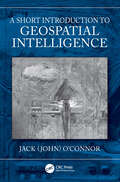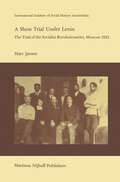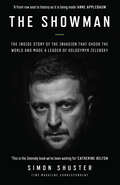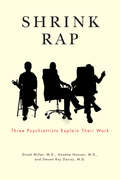- Table View
- List View
A Short Introduction to Geospatial Intelligence
by Jack O'ConnorA Short Introduction to Geospatial Intelligence explains the newest form of intelligence used by governments, commercial organizations, and individuals. Geospatial intelligence combines late 20th century historically derived ways of thinking and early 21st century technologies of GIS, GPS, digital imaging satellites and communications satellites to identify, measure, and analyze the current risk in the world. These ways of thinking have developed from military engineering, cartography, photointerpretation, and imagery analysis. While the oldest example dates back to the early 16th century, all the ways of spatial thinking share the common thread of being developed and refined during conflicts to help military leaders make informed decisions prior to action. In the 21st century— thanks in great part to advances in digital precision technology, miniaturization, and the commercialization of satellites— these ways of thinking have expanded from the military into various other industries and sectors including energy, agriculture, environment, law enforcement, global risk assessment, and climate monitoring. Features: • Analyzes human and algorithmic models for dealing with the challenge of analytic attention, in an age of geospatial data overload • Establishes an original model— envisioning, discovery, recording, comprehending, and tracking— for the spatial thinking that underpins the practice and growth of this emerging discipline • Addresses the effects of small satellites on the collection and analysis of geospatial intelligence A Short Introduction to Geospatial Intelligence describes the development of the five steps in geospatial thinking— envisioning, discovery, recording, comprehending, and tracking— in addition to addressing the challenges, and future applications, of this newest intelligence discipline.
A Short Introduction to Geospatial Intelligence
by Jack O'ConnorA Short Introduction to Geospatial Intelligence explains the newest form of intelligence used by governments, commercial organizations, and individuals. Geospatial intelligence combines late 20th century historically derived ways of thinking and early 21st century technologies of GIS, GPS, digital imaging satellites and communications satellites to identify, measure, and analyze the current risk in the world. These ways of thinking have developed from military engineering, cartography, photointerpretation, and imagery analysis. While the oldest example dates back to the early 16th century, all the ways of spatial thinking share the common thread of being developed and refined during conflicts to help military leaders make informed decisions prior to action. In the 21st century— thanks in great part to advances in digital precision technology, miniaturization, and the commercialization of satellites— these ways of thinking have expanded from the military into various other industries and sectors including energy, agriculture, environment, law enforcement, global risk assessment, and climate monitoring. Features: • Analyzes human and algorithmic models for dealing with the challenge of analytic attention, in an age of geospatial data overload • Establishes an original model— envisioning, discovery, recording, comprehending, and tracking— for the spatial thinking that underpins the practice and growth of this emerging discipline • Addresses the effects of small satellites on the collection and analysis of geospatial intelligence A Short Introduction to Geospatial Intelligence describes the development of the five steps in geospatial thinking— envisioning, discovery, recording, comprehending, and tracking— in addition to addressing the challenges, and future applications, of this newest intelligence discipline.
Shortcomings in the EU Merger Directive (Series on International Taxation)
by Frederik BoulogneThe European Union (EU) Merger Directive removes certain tax disadvantages encountered by companies and their shareholders in the course of a restructuring operation. However, in spite of amendments and European Court of Justice's (ECJ) interpretations of its provisions, various shortcomings remain. This thoroughgoing analysis, broader and deeper than any prior work on the subject, addresses all the Directive's subtopics methodically, following the paragraphs of Articles 1-15 in their logical succession. The author analyses the points in which the Merger Directive falls short of attaining its stated objective, and he also examines how these shortcomings could be scaled. To do so, he tests the Merger Directive against its own objective, primary EU law (the fundamental freedoms and the unwritten general principles of EU law) and non-discrimination provisions in relevant treaties. Each of the following questions is addressed and responded to in depth: – Which entities have access to the Merger Directive and which entities should have access to it? – Which operations are covered by the Merger Directive and which operations should be covered? – Which tax disadvantages to cross-border restructuring operations does the Merger Directive aim to remove, which tax disadvantages have been actually removed, which tax disadvantages remain, and how should the Merger Directive be amended to remove the remaining tax disadvantages? – How tax avoidance should be combated under Article 15(1)(a) of the Merger Directive, which possible types of tax avoidance can be identi¬fied, and how the Merger Directive should be amended? – Which cases of double taxation does a taxpayer engaging in cross-border restructuring operations potentially encounter, and how they can be taken away by the Merger Directive? The key shortcomings that are identifi¬ed are: the Merger Directive’s objective is not stated precisely; minimum harmonisation does not lead to a common tax system; exhaustive lists are used as legislative technique; the Merger Directive does not add much to the outcomes reached through negative harmonisation; and the de¬finitions of qualifying operations are not fully aligned with corporate law. Chapter 6 contains a deeply informed and viable proposal for the amendment of the Merger Directive. This is the fi¬rst treatment not only to evaluate the Directive's effi¬cacy in detail but also to offer real solutions to its shortcomings. It will be welcomed by policymakers, judges, practitioners and academics, and the recommendations it contains are sure to affect ongoing amendments and jurisprudence on the Merger Directive.
Shot Range Determination (Forensic Science Progress #6)
by Karl SellierThe range at which a weapon has been fired is an important measurement for the reconstruction of firearms offenses (murder, suicide, accident). All changes caused by a shot and which vary according to the distance from the weapon are suitable in principle for determining this distance. However, some procedures are very elegant in theory but hardly applicable in practice. The constructions of ammunition and the sequence of events during a shot are dealt with first as this knowledge forms a basis for understanding the various methods. \ The individual zones (classes) of firing distances (contact shot, intermediate shot, distance shot) are described. In this connection, the morphological methods for determining the firing distance are discussed. From the shape and size of the powder residue distribution (soot stains, powder tattooing) and with the knowledge of the weapon and ammunition, the distance from the target can be elucidated. In this chapter, the methods of making an invisible distribution visible are also dealt with. In order to determine the range of the shot from the appearance of the wound no complicated apparatus is necessary. One can judge with the naked eye. These procedures have a great advantage over the methods discussed in the following chapter in that they give stronger proof. They are more vivid and convincing for the uninitiated (judge or jury) than abstract measurements obtained by scientific devices.
Should A Doctor Tell?: The Evolution of Medical Confidentiality in Britain
by Angus H. FergusonMedical confidentiality has long been recognised as a core element of medical ethics, but its boundaries are under constant negotiation. Areas of debate in twenty-first century medicine include the use of patient-identifiable data in research, information sharing across public services, and the implications of advances in genetics. This book provides important historical insight into the modern evolution of medical confidentiality in the UK. It analyses a range of perspectives and considers the broader context as well as the specific details of debates, developments and key precedents. With each chapter focusing on a different issue, the book covers the common law position on medical privilege, the rise of public health and collective welfare measures, legal and public policy perspectives on medical confidentiality and privilege in the first half of the twentieth century, contestations over statutory recognition for medical privilege and Crown privilege. It concludes with an overview of twentieth century developments. Bringing fresh insights to oft-cited cases and demonstrating a better understanding of the boundaries of medical confidentiality, the book discusses the role of important interest groups such as the judiciary, Ministry of Health and professional medical bodies. It will be directly relevant for people working or studying in the field of medical law as well as those with an interest in the interaction of law, medicine and ethics.
Should A Doctor Tell?: The Evolution of Medical Confidentiality in Britain
by Angus H. FergusonMedical confidentiality has long been recognised as a core element of medical ethics, but its boundaries are under constant negotiation. Areas of debate in twenty-first century medicine include the use of patient-identifiable data in research, information sharing across public services, and the implications of advances in genetics. This book provides important historical insight into the modern evolution of medical confidentiality in the UK. It analyses a range of perspectives and considers the broader context as well as the specific details of debates, developments and key precedents. With each chapter focusing on a different issue, the book covers the common law position on medical privilege, the rise of public health and collective welfare measures, legal and public policy perspectives on medical confidentiality and privilege in the first half of the twentieth century, contestations over statutory recognition for medical privilege and Crown privilege. It concludes with an overview of twentieth century developments. Bringing fresh insights to oft-cited cases and demonstrating a better understanding of the boundaries of medical confidentiality, the book discusses the role of important interest groups such as the judiciary, Ministry of Health and professional medical bodies. It will be directly relevant for people working or studying in the field of medical law as well as those with an interest in the interaction of law, medicine and ethics.
Should Prometheus be Bound?: Corporate Global Responsibility
by Philippe de WootThis book proposes a critical analysis of the new corporate responsibilities in a globalizing world. It is built around the creative and entrepreneurial power of the business firm and the new opportunities and challenges offered by science and technology, globalization and deregulation. Rather than focusing on tools, techniques and existing practices, it is the first to offer a conceptual and critical analysis of the new trend towards Corporate Social Responsibility. It argues that the legitimacy of the corporation will depend more and more on the contribution it wants to bring to our transition towards sustainable development.
Should the Patient Know the Truth?: A Response of physicians, nurses, clergymen, and lawyers
by Samuel Standard Helmuth M. NathanShould Trees Have Standing?: Law, Morality, and the Environment
by Christopher D. StoneOriginally published in 1972, Should Trees Have Standing? was a rallying point for the then burgeoning environmental movement, launching a worldwide debate on the basic nature of legal rights that reached the U.S. Supreme Court. Now, in the 35th anniversary edition of this remarkably influential book, Christopher D. Stone updates his original thesis and explores the impact his ideas have had on the courts, the academy, and society as a whole. At the heart of the book is an eminently sensible, legally sound, and compelling argument that the environment should be granted legal rights. For the new edition, Stone explores a variety of recent cases and current events--and related topics such as climate change and protecting the oceans--providing a thoughtful survey of the past and an insightful glimpse at the future of the environmental movement. This enduring work continues to serve as the definitive statement as to why trees, oceans, animals, and the environment as a whole should be bestowed with legal rights, so that the voiceless elements in nature are protected for future generations.
Should Trees Have Standing?: Law, Morality, and the Environment
by Christopher D. StoneOriginally published in 1972, Should Trees Have Standing? was a rallying point for the then burgeoning environmental movement, launching a worldwide debate on the basic nature of legal rights that reached the U.S. Supreme Court. Now, in the 35th anniversary edition of this remarkably influential book, Christopher D. Stone updates his original thesis and explores the impact his ideas have had on the courts, the academy, and society as a whole. At the heart of the book is an eminently sensible, legally sound, and compelling argument that the environment should be granted legal rights. For the new edition, Stone explores a variety of recent cases and current events--and related topics such as climate change and protecting the oceans--providing a thoughtful survey of the past and an insightful glimpse at the future of the environmental movement. This enduring work continues to serve as the definitive statement as to why trees, oceans, animals, and the environment as a whole should be bestowed with legal rights, so that the voiceless elements in nature are protected for future generations.
A Show Trial Under Lenin: The Trial of the Socialist Revolutionaries, Moscow 1922 (Studies in Social History #7)
by M. JansenSoviet Russia will conquer all the millions of problems that stand in its way, on one condition: as long as the cause of the political education of the broad masses of the people continually advances. We have nothing to be afraid of, if our people fully learns to distinguish who are its friends and who are its enemies. The trial of the Socialist Revolutionaries must and shall be a great step forward in the cause of the political instruction of the very broadest masses in town and country. (Grigorii Zinov'ev, Pravda and Krasnaia gazeta, 20 June 1922) For my part, I considered this trial to be unnecessary: the Socialist Revolu tionaries had been beaten and represented no visible danger at all. (Charles Rappoport, Ma vie, Paris 1926-1927, Vol. 2, p. 80) The Bolsheviks seized power in Russia in October 1917 by staging a coup d'etat, and then established a dictatorship. The new rulers sup pressed all armed resistance in a bloody civil war, after which they made every effort to uproot and exterminate even peaceful political opposition of all kinds. Even now it is impossible in the Soviet Union to subject these developments to critical historical study. The political opponents of the Soviet regime of the time are still regarded by official Soviet his toriography as counter-revolutionaries and the measures taken against them are seen as completely justified.
Show Trials: Stalinist Purges in Eastern Europe, 1948-1954
by George H. HodosShow Trials combines first-hand knowledge with hitherto unpublished, confidential material, to offer a penetrating and candid account of the Stalinist purges that occurred in Albanian, East German, Bulgarian, and Rumanian purges, as well as in Hungary, Czechoslovakia, and Poland. George Hodos shows how these trials played a pivotal role in consolidating Soviet domination over the satellite countries during Stalin's lifetime. As an important addition to our understanding of these events and times, Show Trials is essential for historians of Eastern Europe and absorbing reading for anyone interested in world affairs.
Showing Remorse: Law and the Social Control of Emotion
by Richard WeismanWhether or not wrongdoers show remorse and how they show remorse are matters that attract great interest both in law and in popular culture. In capital trials in the United States, it can be a question of life or death whether a jury believes that a wrongdoer showed remorse. And in wrongdoings that capture the popular imagination, public attention focuses not only on the act but on whether the perpetrator feels remorse for what they did. But who decides when remorse should be shown or not shown and whether it is genuine or not genuine? In contrast to previous academic studies on the subject, the primary focus of this work is not on whether the wrongdoer meets these expectations over how and when remorse should be shown but on how the community reacts when these expectations are met or not met. Using examples drawn from Canada, the United States, and South Africa, the author demonstrates that the showing of remorse is a site of negotiation and contention between groups who differ about when it is to be expressed and how it is to be expressed. The book illustrates these points by looking at cases about which there was conflict over whether the wrongdoer should show remorse or whether the feelings that were shown were sincere. Building on the earlier analysis, the author shows that the process of deciding when and how remorse should be expressed contributes to the moral ordering of society as a whole. This book will be of interest to those in the fields of sociology, law, law and society, and criminology.
Showing Remorse: Law and the Social Control of Emotion (Law, Justice And Power Ser.)
by Richard WeismanWhether or not wrongdoers show remorse and how they show remorse are matters that attract great interest both in law and in popular culture. In capital trials in the United States, it can be a question of life or death whether a jury believes that a wrongdoer showed remorse. And in wrongdoings that capture the popular imagination, public attention focuses not only on the act but on whether the perpetrator feels remorse for what they did. But who decides when remorse should be shown or not shown and whether it is genuine or not genuine? In contrast to previous academic studies on the subject, the primary focus of this work is not on whether the wrongdoer meets these expectations over how and when remorse should be shown but on how the community reacts when these expectations are met or not met. Using examples drawn from Canada, the United States, and South Africa, the author demonstrates that the showing of remorse is a site of negotiation and contention between groups who differ about when it is to be expressed and how it is to be expressed. The book illustrates these points by looking at cases about which there was conflict over whether the wrongdoer should show remorse or whether the feelings that were shown were sincere. Building on the earlier analysis, the author shows that the process of deciding when and how remorse should be expressed contributes to the moral ordering of society as a whole. This book will be of interest to those in the fields of sociology, law, law and society, and criminology.
The Showman: The Inside Story Of The Invasion That Shook The World And Made A Leader Of Volodymyr Zelensky
by Simon Shuster‘This book offers a front row seat to history as it is being made’ ANNE APPLEBAUM 'This is the Zelensky book we’ve been waiting for’ CATHERINE BELTON 'An elegant account of the invasion’s first year as seen by those in the very eye of the storm' DAILY TELEGRAPH
Shrikes and Bush-shrikes: Including Wood-shrikes, Helmet-shrikes, Shrike Flycatchers, Philentomas, Batises and Wattle-eyes (Helm Identification Guides)
by Tony HarrisCovering the identification, biology and relationships of all true shrikes, bush-shrikes, helmet-shrikes, wood-shrikes, shrike flycatchers, philentomas, batises and wattle-eyes this book offers information on 114 species in 21 genera within the families Laniidae and Malaconotidae. For each genus, acoustic and visual signals are summarized and used to map similarities.The detailed species account for the bulk of the book, providing knowledge on field identification, plumage descriptions, geographical variation, moult, distribution, movements. general and foraging behaviour, food, sounds and breeding behaviour."
Shrink Rap: Three Psychiatrists Explain Their Work
by Dinah Miller Annette Hanson Steven Roy DavissFinally, a book that explains everything you ever wanted to know about psychiatry!In Shrink Rap, three psychiatrists from different specialties provide frank answers to questions such as:• What is psychotherapy, how does it work, and why don't all psychiatrists do it?• When are medications helpful?• What happens on a psychiatric unit?• Can Prozac make people suicidal?• Why do many doctors not like Xanax?• Why do we have an insanity defense?• Why do people confess to crimes they didn't commit?Based on the authors' hugely popular blog and podcast series, this book is for patients and everyone else who is curious about how psychiatrists work. Using compelling patient vignettes, Shrink Rap explains how psychiatrists think about and address the problems they encounter, from the mundane (how much to charge) to the controversial (involuntary hospitalization). The authors face the field's shortcomings head-on, revealing what other doctors may not admit about practicing psychiatry. Candid and humorous, Shrink Rap gives a closeup view of psychiatry, peering into technology, treatments, and the business of the field. If you've ever wondered how psychiatry really works, let the Shrink Rappers explain.
Shylock on Trial: The Appellate Briefs (Chicago Shorts)
by Richard A. Posner Charles FriedWilliam Shakespeare is inextricably linked with the law, his plays rich in its terms, settings, and thought processes. In Shylock on Trial: The Appellate Briefs, the Hon. Richard A. Posner and Charles Fried rule on Shakespeare’s classic drama The Merchant of Venice. Framed as a decision argued by two appellate judges of the period in a trial following Shylock’s sentencing by the Duke of Venice, these essays playfully walk the line between law and culture, dissecting the alleged legal inconsistencies of Shylock’s trial while engaging in an artful reading of the play itself. The resultant opinions shed fresh light on the relationship between literary and legal scholarship, demonstrating how Shakespeare’s thinking about legal concepts and legal practice points to a deep and sometimes vexed engagement with the law’s technical workings, its underlying premises, and its social effects.
Siblings and the Family Business: Making it Work for Business, the Family, and the Future (A Family Business Publication)
by NA NAThe family business becomes much more complex as it goes from the founder to next generations. As more family members work together several challenges become apparent and can threaten the business if not addressed. This book shows the family members how to confront the problems and how to create solutions.
Sicherheit von Medizingeräten: Recht - Risiko - Chancen
by Norbert LeitgebIn diesem Buch werden die Rahmenbedingungen und Zusammenhänge der Entwicklung, Konformitätsbewertung und Überprüfung von Medizingeräten vermittelt. Es beschreibt, welche Hürden und Fallstricke ein Hersteller zu überwinden hat und welche Gestaltungsmöglichkeiten gegeben sind, um Medizingeräte auf den Europäischen Markt bringen zu können. Der Autor erläutert, welche Faktoren die Risikowahrnehmung bestimmen und welche Schutzziele einzuhalten sind, und er beschreibt, wie der Risikomanagementprozess mit Risikoanalyse, -bewertung, -beherrschung und -kontrolle umzusetzen ist, um die Sicherheit und Konformität von Medizingräten zu gewährleisten.Das Buch liegt nun in der 2. aktualisierten Auflage vor. Aspekte der medizinischen Software und des Qualitätsmanagements wurden stärker berücksichtigt und das neue Medizinprodukterecht mit Konformitätsbewertung und Marktzulassungserfordernissen behandelt.
Sicherheiten im Bauwesen nach Ansprüchen (Bau- und Architektenrecht nach Ansprüchen)
by Christiane Frye Barbara MünchDer Bauvertrag ist ein Langzeitvertrag. Das Bedürfnis der am Bau Beteiligten nach Absicherung ihrer Ansprüche ist daher berechtigterweise groß. Dieses Praxisbuch wendet sich gleichermaßen an Auftraggeber und Auftragnehmer und beleuchtet das Recht gesetzlicher wie auch vertraglicher Sicherheiten umfassend, aber stets prägnant und praxisorientiert. Innerhalb der jeweiligen Sicherungsarten werden die Voraussetzungen aufgeführt, Probleme und Fallstricke beleuchtet und Rechtsfolgen aufgezeigt. Die Darstellung wird durch Übersichten ergänzt, aus denen sich die jeweiligen Anspruchsvoraussetzungen, Rechtsfolgen und Möglichkeiten der gerichtlichen Durchsetzung der Ansprüche überblicksartig ergeben.
Sicherheitsethik (Studien zur Inneren Sicherheit #16)
by Regina Ammicht QuinnSicherheitsethik ist ein neues Feld. Der vorliegende Band ist der erste, der sich mit diesen Fragen systematisch befasst. Die Notwendigkeit einer Sicherheitsethik entstand aus der Tatsache, dass ‚Sicherheit’ in den unterschiedlichsten gesellschaftlichen Bereichen zu einem Leitmotiv geworden ist. Dieses Leitmotiv nimmt im persönlichen wie auch dem gesellschaftlichen Leben mittlerweile die Form eines grundlegenden Werts an. Welche Folgen und Implikationen unterschiedliche Verständnisse von Sicherheit haben; wie das Zusammenspiel von Kontexten und Sicherheitsbegriffen gestaltet ist, wie Formen der politischen, gesellschaftlichen, persönlichen und technologischen Herstellung von Sicherheit zu verstehen und zu bewerten sind, welche Menschen in welcher Weise von welcher Form von Sicherheit profitieren, eingeschränkt oder sogar beschädigt werden – dies sind nur einige wenige Fragen im Kontext einer Sicherheitsethik.
Sicherheitsforschung: Chancen und Perspektiven (acatech DISKUTIERT)
by Friedrich-Wilhelm Bach Petra Winzer Eckehard SchniederWissenschaft und Technik dienen dazu, das Grundbedürfnis nach Sicherheit zu befriedigen. Weil aber der Sicherheitsbegriff nicht einheitlich verwendet wird, sind Modelle und Lösungskonzepte zur Gewährleistung von Sicherheit sehr heterogen. Dies demonstrieren die Beiträge der Autoren. Sie gehen davon aus, dass die begriffliche Trennung zwischen Security und Safety bei der Entwicklung neuer Technologien überwunden werden muss. Der Band erscheint in der Reihe „acatech diskutiert" und ist ein erstes Diskussionsergebnis des Themennetzwerks „Sicherheit".
Sicherung von Property Rights bei komplexer Leistungserstellung: Vergleichende Untersuchung von Wirtschaftsmediation und Claim Management (Fokus Dienstleistungsmarketing)
by Sven Christoph HallscheidtSven Christoph Hallscheidt setzt sich mit der grundsätzlichen Frage auseinander, wie die Vertragsparteien in komplexen Transaktionen ihre Handlungs- und Verfügungsrechte (Property Rights) sichern können, und untersucht, inwieweit die in der Praxis eingesetzten Verfahren der Mediation und des Claim Management dazu geeignet sind und worin ihre Vor- und Nachteile liegen.
Sicherungsinfrastrukturen: Gestaltungsvorschläge für Technik, Organisation und Recht
by Volker HammerDie wachsende Telekommunikation erfordert neue Sicherungsinfrastrukturen. Das Buch informiert interdisziplinär über Voraussetzungen und Gestaltung solcher Infrastrukturen.




















